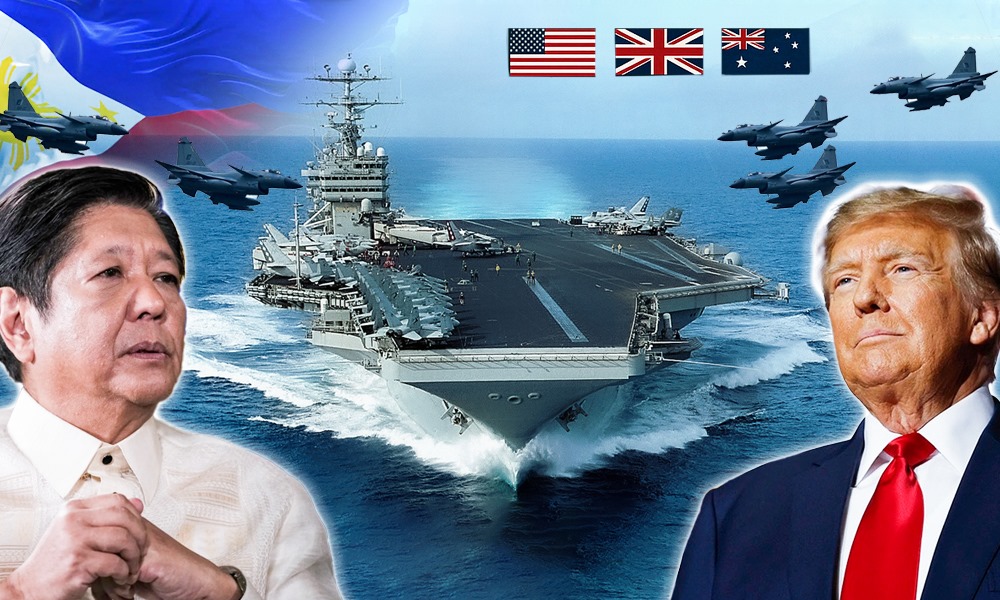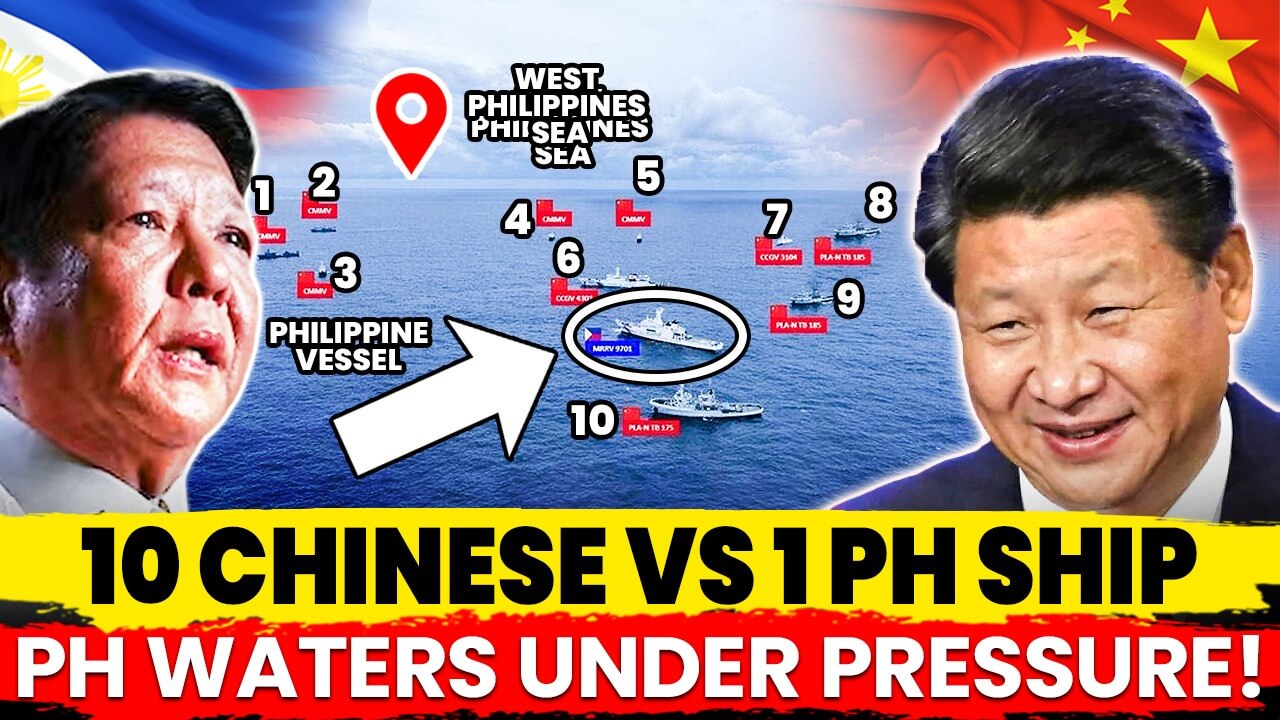It’s not just another carrier docking, it’s a global message. That’s how a U.S. Navy officer summed it up as the USS George Washington, a 100,000-ton symbol of American naval dominance, sailed into Manila Bay, drawing the eyes of both allies and rivals across the Indo-Pacific. On the shoreline, Filipino fishermen watched silently as the massive warship moved into view, a steel giant carrying not just aircraft, but intention. Meanwhile, thousands of miles away, the UK Carrier Strike Group was slicing through the Indian Ocean, headed straight for Australia to join Talisman Sabre 2025, one of the largest and most complex military exercises on Earth. But this isn’t just about drills and deployments, it’s about red lines being drawn in blue waters, alliances deepening, and the world’s major powers preparing for a future that feels increasingly uncertain. Because the Indo-Pacific is no longer just a trade route, it’s the world’s most volatile geopolitical flashpoint. With $5.5 trillion in global commerce flowing through these waters annually, over 200 naval standoffs in the South China Sea last year alone, and military budgets across the region hitting record highs, this is no longer a show of strength, it’s a test of resolve. The only question now is: are these moves aimed at preventing the next war, or quietly preparing for it?
USS George Washington’s Return to the Philippines: Not Just a Visit — A Statement to the World
When the USS George Washington, one of the world’s most powerful warships, arrived in Manila Bay, it wasn’t just a port call, it was a thunderous reminder of America’s deep-rooted alliance with the Philippines. Nicknamed the “GW,” this Nimitz-class nuclear-powered aircraft carrier is a floating fortress, capable of launching over 70 aircraft and carrying more than 5,000 sailors and marines. But its return to the Philippines isn’t about showing off hardware, it’s about signaling strength, unity, and unwavering commitment in the face of growing tension in the Indo-Pacific.
The timing couldn’t be more critical. The Philippines sits at the heart of the South China Sea, a region where territorial disputes are heating up and where over $5.5 trillion in global trade flows annually. Chinese vessels have increasingly clashed with Filipino fishing boats and patrol ships, prompting a louder call for deterrence and defense. That’s where the USS George Washington fits in, not just as a ship, but as a message. With the Enhanced Defense Cooperation Agreement (EDCA) now expanding, the U.S. military has access to nine key sites across the Philippines, giving Washington greater operational reach from Luzon to Palawan. This isn’t theoretical power, it’s boots, jets, and strategy on the ground.
But beyond firepower, the USS George Washington carries a legacy of humanitarian leadership. When Super Typhoon Haiyan (Yolanda) slammed into the Philippines in 2013, it was this very carrier that rushed to the disaster zone. Within hours, its helicopters were delivering clean water, food, and medical support to devastated communities, showing the world that a warship can also be a lifeline. In military terms, this is known as Humanitarian Assistance and Disaster Relief (HADR), and the GW has proven to be an unmatched asset in times of crisis. Its return to Philippine waters reassures not only policymakers, but millions of Filipinos who remember its aid in times of desperation.
From a strategic and economic standpoint, the impact is huge. The ship itself costs over $4.5 billion to build and more than $1 billion per year to operate, a symbol of the immense investment behind America’s regional posture. And for the local economy? Every port visit by a carrier like the GW injects millions of pesos into local businesses, hotels, restaurants, taxis, and markets all benefit overnight. For Manila, the sight of thousands of American sailors exploring the city isn’t just a cultural exchange, it’s a mini economic boom.
In short, the USS George Washington’s return to the Philippines is far more than a military move. It’s a powerful reminder of a decades-long alliance built on shared values, mutual defense, and regional stability. As the Indo-Pacific becomes the stage for global competition, the Philippines is once again proving its central role, and America is showing that it’s here, not just to stay, but to stand with its oldest ally in Asia.
UK Carrier Strike Group Heads to Talisman Sabre 2025: Britain’s Indo-Pacific Comeback
The Royal Navy is back in the Indo-Pacific, and it’s not coming quietly. One of the UK’s most advanced war machines, the Queen Elizabeth-class aircraft carrier, either HMS Queen Elizabeth or HMS Prince of Wales, is now leading a UK Carrier Strike Group (CSG) toward Australia, preparing to join Talisman Sabre 2025, a massive war-game exercise that’s fast becoming one of the most critical military drills on Earth. This is not just a show of force, it’s the sharp edge of Britain’s “Indo-Pacific Tilt” policy turning into action.
Why is this significant? Because the UK is no longer just watching from the sidelines. It’s actively pivoting toward the Indo-Pacific, joining the frontlines of a region that now defines global stability, trade, and future conflict. As one British defense official put it bluntly: “This is about securing the rules-based order. Our presence shows we mean business.” With global tensions simmering, especially in the South China Sea and Taiwan Strait, the UK’s presence alongside U.S. and Australian forces is both symbolic and strategic.
Talisman Sabre 2025 isn’t just another exercise, it’s the Indo-Pacific’s premier multinational war drill, involving advanced air combat, amphibious landings, and full-spectrum warfare. In 2023, it brought together over 30,000 troops from 13 nations, including Japan, South Korea, and Canada. This year’s edition is expected to be even bigger, with more integrated naval-air operations and cyber-defense scenarios. And now, the Royal Navy’s CSG is stepping right into the thick of it.
At the center of the UK task force is a floating powerhouse: a 65,000-ton aircraft carrier designed to launch and recover F-35B Lightning II stealth jets, some of the most advanced fighters in the world. Each carrier can carry up to 36 F-35Bs, offering formidable strike capability and advanced surveillance. But that’s just the beginning. The CSG sails with a full complement of escort ships, Type 45 destroyers, Type 23 frigates, submarines, and support vessels, making it a mobile fortress at sea.
This deployment isn’t just about raw power, it’s about interoperability. During Talisman Sabre, UK pilots will conduct joint air missions with U.S. and Australian forces, running complex air defense and amphibious strike operations that simulate real wartime conditions. These exercises tighten the bonds between allies, ensuring that when it counts, their forces can operate like one unified military machine.
And behind the scenes? There’s a deeper layer. This deployment reinforces AUKUS, the trilateral security pact between Australia, the UK, and the U.S., aimed at shaping the future of defense technology, from AI and cyber to hypersonic weapons and nuclear-powered submarines. The UK’s presence in the Indo-Pacific directly supports AUKUS Pillar 2, which focuses on advanced capabilities and joint development, making the strike group not just a warfighting asset, but a floating testbed for future warfare.
In short, the UK’s Carrier Strike Group sailing into Talisman Sabre 2025 isn’t just an exercise in naval diplomacy, it’s a clear and present signal. The Indo-Pacific is no longer just an American concern. It’s a collective front line, where democratic nations are standing shoulder to shoulder to uphold freedom of navigation, regional security, and the global balance of power. And Britain, with its carrier strike group in formation, has made it clear: they’re not just watching history unfold, they’re helping write it.
Geopolitical Significance and What Comes Next: The Indo-Pacific Chessboard Is in Motion
What we’re witnessing right now in the Indo-Pacific isn’t just about ships moving across oceans, it’s a high-stakes power play unfolding in real time. With the USS George Washington docking in Manila and the UK Carrier Strike Group slicing through the Indian Ocean toward Australia, the message is crystal clear: the world’s leading democracies are no longer waiting for tensions to erupt, they’re actively shaping the rules of engagement.
This coordinated show of force is a direct counterbalance to the increasing assertiveness of regional powers, particularly in the South China Sea and around Taiwan. By sailing together, training together, and integrating high-tech operations, these navies are doing more than just drills, they’re reinforcing the rules-based international order. One defense analyst summed it up best: “This is about deterrence by presence. These aren’t just ships, they’re moving messages.”
What’s just as striking is the multilateral nature of these deployments. Gone are the days of unilateral shows of power. Today, the future of Indo-Pacific security rests in alliances like AUKUS, partnerships like the Quad, and long-standing agreements like the Five Power Defence Arrangements. Talisman Sabre itself is no longer just a U.S.-Australia operation, it’s evolved into a multinational network of coordinated strength, information sharing, and combined capability.
Subic to Batangas 250KM Railway Project: A Dual-Purpose Strategic Infrastructure
Looking ahead, this is only the beginning. Expect to see more joint patrols, expanded military exercises, and cutting-edge technologies, like AI-powered surveillance, cyber defense systems, and even unmanned sea drones, becoming regular features of regional cooperation. The focus is shifting toward “integrated deterrence”, meaning not just responding to threats, but preventing them through seamless coordination across air, sea, space, and cyberspace.
The Indo-Pacific is no longer just a region, it’s the global arena for competition, cooperation, and confrontation. Every deployment, every exercise, every port visit now sends a ripple that’s felt from Washington to Canberra, Tokyo to London, and Beijing to Manila. And as this dynamic theater continues to evolve, one thing is clear: the battle for influence in the Indo-Pacific is already underway, and it’s not being fought in the future. It’s happening right now.
Conclusion: A Stronger, More United Indo-Pacific
As the nuclear-powered USS George Washington anchors in Manila and the UK Carrier Strike Group surges toward the Australian coast for Talisman Sabre 2025, the world is watching a powerful transformation take shape. These aren’t isolated maneuvers, they’re living proof of revitalized alliances, deeper military trust, and shared strategic purpose. Together, they reaffirm a collective commitment to peace, stability, and deterrence in a region that holds the key to global security. And looking forward, the message couldn’t be clearer: the Indo-Pacific is no longer a loosely connected patchwork of interests, it’s becoming a tightly woven security architecture, built on partnership, presence, and readiness. The era of fragmented responses is over. What we’re seeing now is a vision of the future, a more integrated, resilient, and united Indo-Pacific, ready to stand firm in defense of a free and open world.



